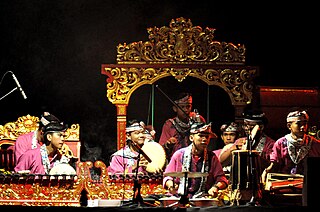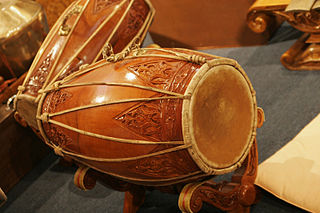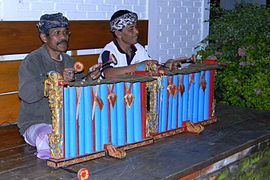
Gamelan is the traditional ensemble music of the Javanese, Sundanese, and Balinese peoples of Indonesia, made up predominantly of percussive instruments. The most common instruments used are metallophones played by mallets and a set of hand-played drums called kendhang, which register the beat. The kemanak and gangsa are commonly used gamelan instruments in Java. Other instruments include xylophones, bamboo flutes, a bowed instrument called a rebab, siter, and vocalists named sindhen (Female) or gerong (Male).

Pelog is one of the essential tuning systems used in gamelan instruments that has heptatonic scale. The other, older, scale commonly used is called slendro. Pelog has seven notes, but many gamelan ensembles only have keys for five of the pitches. Even in ensembles that have all seven notes, many pieces only use a subset of five notes.

SlendroPlay (help·info) is one of the essential tuning systems used in gamelan instruments that has pentatonic scale. Based on Javanese mythology, the Slendro Gamelan tuning system is older than the pélog tuning system.

Jegog is a form of gamelan music indigenous to Bali, Indonesia, played on instruments made of bamboo. The tradition of jegog is centered in Jembrana, a region in Western Bali. In recent years jegog has started to become popular in other regions of Bali with a few groups being established in central Bali to entertain tourists. International interest has been spread by tourists visiting Bali and by recordings. There are virtually no ensembles outside of Bali with the exception of at least two groups in Japan, one in the United States and one in Germany. Jegog music is very fast, loud, rhythmic and precise. Pieces last from a few minutes to as long as thirty minutes.

Gamelan gong kebyar is a style or genre of Balinese gamelan music of Indonesia. Kebyar means "to flare up or burst open", and refers to the explosive changes in tempo and dynamics characteristic of the style. It is the most popular form of gamelan in Bali, and its best known musical export.

Joged bumbung is a style of gamelan music from Bali, Indonesia on instruments made primarily out of bamboo. The ensemble gets its name from joged, a flirtatious dance often performed at festivals and parties. This style of Gamelan is especially popular in Northern and Western Bali, but is easily found all over the island. Unlike many styles of Balinese Gamelan which have sacred roles in religious festivals, Joged music is much more secular, and in many ways has become the folk music of Bali. With the rapid rise of tourism in recent decades, Joged music is now often found being performed at hotels and restaurants.

The angklung is a musical instrument from the Sundanese people in Indonesia made of a varying number of bamboo tubes attached to a bamboo frame. The tubes are carved to have a resonant pitch when struck and are tuned to octaves, similar to Western handbells. The base of the frame is held in one hand, while the other hand shakes the instrument, causing a repeating note to sound. Each performer in an angklung ensemble is typically responsible for just one pitch, sounding their individual angklung at the appropriate times to produce complete melodies . The angklung is popular throughout the world, but it originated in what is now West Java and Banten provinces in Indonesia, and has been played by the Sundanese for many centuries. The angklung and its music have become an important part of the cultural identity of Sundanese communities. Playing the angklung as an orchestra requires cooperation and coordination, and is believed to promote the values of teamwork, mutual respect and social harmony.

Kotekan is a style of playing fast interlocking parts in most varieties of Balinese Gamelan music, including Gamelan gong kebyar, Gamelan angklung, Gamelan jegog and others.

The Music of Java embraces a wide variety of styles, both traditional and contemporary, reflecting the diversity of the island and its lengthy history. Apart from traditional forms that maintain connections to musical styles many centuries old, there are also many unique styles and conventions which combine elements from many other regional influences, including those of neighbouring Asian cultures and European colonial forms.

A gangsa is a type of metallophone which is used mainly in Balinese and Javanese Gamelan music in Indonesia. In Balinese gong kebyar styles, there are two types of gangsa typically used: the smaller, higher pitched kantilan and the larger pemade. Each instrument consists of several tuned metal bars each placed over an individual resonator. The bars are hit with a wooden panggul, each producing a different pitch. Duration of sound intensity and sound quality factors are generally accomplished by damping the vibration of the bar with the fingers of the free hand. Balinese gong kebyar gangsas, as with other metallophones in gong kebyar ensembles, are played in neighboring pairs with interlocking, rapid-tempo parts that elaborate on the melody of a piece of music ; these pairs are tuned to be dissonant and create certain wavelengths of sympathetic vibrations to create a shimmering tone that travels long distances. The gangsa is very similar to the old gendér and the saron.

A gendèr is a type of metallophone used in Balinese and Javanese gamelan music. It consists of 10 to 14 tuned metal bars suspended over a tuned resonator of bamboo or metal, which are tapped with a mallet made of wooden disks (Bali) or a padded wooden disk (Java). Each key is a note of a different pitch, often extending a little more than two octaves. There are five notes per octave, so in the seven-note pélog scale, some pitches are left out according to the pathet. Most gamelans include three gendèr, one for sléndro, one for pelog pathet nem and lima, and one for pelog pathet barang.

A kempul is a type of hanging gong used in Indonesian gamelan. The kempul is a set of pitched, hanging, knobbed gongs, often made of bronze, wood, and cords. Ranging from 19 cm to 25,4 cm in diameter, the kempul gong has a flat surface with a protruding knob at the center and is played by hitting the knob with the "soft end of a mallet." "The wooden mallet used has a ball shape head with heavy padding on a short wooden handle. The number of kempul gongs present in a gamelan ensemble varies but, "although there can be two to ten kempul on one separate rack, it is common to have five kempul hanging on the same rack as the Gong ageng and gong siyem".

Gamelan beleganjur is one of the most popular styles of gamelan music in Bali. Its closest Western analogue is probably the Western military band.

Gamelan semar pegulingan is an old variety of the Balinese gamelan. Dating back from around the 17th century, the style is sweeter and more reserved than the more popular and progressive Gamelan Gong Kebyar. Semar pegulingan is derived from the ancient flute ensemble gamelan gambuh which utilizes a 7 tone scale. Semar pegulingan also uses the 7 tone scale which enables several pathet to be played. Semar is the name of the Hindu God of love and pegulingan means roughly 'laying down'. It was originally played near the sleeping chambers of the palace to lull the king and his concubines to sleep. The ensemble includes suling, various small percussion instruments similar to sleigh bells and finger cymbals, and trompong - a row of small kettle gongs that play the melody. A similar type of ensemble, Gamelan Pelegongan, substitutes a pair of gendérs for the trompong as the melody carrier and plays the music for a set of dances known as legong.

Gamelan Sekar Jaya is a Balinese gamelan ensemble located in the San Francisco Bay Area. It has been called "the finest Balinese gamelan ensemble outside of Indonesia" by Indonesia’s Tempo Magazine. It performs the music and dance of Bali in many different genres of Balinese gamelan, mainly gamelan gong kebyar, gamelan angklung, gender wayang, and gamelan jegog. Past performances have also featured ensembles playing in other styles as well, including gamelan joged bumbung, kecak, gender batel, gamelan gambuh, genggong, and beleganjur. GSJ has also performed contemporary pieces featuring instruments from the Western tradition.

Kendang or Gendang is a two-headed drum used by people from the Indonesian Archipelago. Kendang is one of the primary instruments used in the Gamelan ensembles of Javanese, Sundanese, and Balinese, the Kendang ensemble as well as various Kulintang ensembles in Indonesia, Brunei, Malaysia, Singapore, and the Philippines. It is constructed in a variety of ways by different ethnic groups. It is a relation to the Indian mridangam double-headed drum.
Pathet is an organizing concept in central Javanese gamelan music in Indonesia. It is a system of tonal hierarchies in which some notes are emphasized more than others. The word means '"to damp, or to restrain from" in Javanese. Pathet is "a limitation on the player's choice of variation, so that while in one pathet a certain note may be prominent, in another it must be avoided, or used only for special effect. Awareness of such limitations, and exploration of variation within them reflects a basic philosophical aim of gamelan music, and indeed all art in central Java, namely, the restraint and refinement of one's own behaviour." Javanese often give poetic explanations of pathet, such as "Pathet is the couch or bed of a melody." In essence, a pathet indicates which notes are stressed in the melody, especially at the end of phrases (seleh), as well as determines which elaborations are appropriate. In many cases, however, pieces are seen as in a mixture of pathets, and the reality is often more complicated than the generalizations indicated here, and depend on the particular composition and style.
I Wayan Suweca is one of the most highly respected performers of Balinese gamelan. Since the 1970s, he taught and performed extensively around Asia, Europe and America. In the early 1980s, along with his students Michael Tenzer and Rachel Ann Cooper, he founded and led the famous Sekar Jaya gamelan ensemble in Berkeley, California. In 1993, he cofounded the ensemble Giri Kedaton in Montreal. From 1982 to 2004, he was professor at the National Arts Academy of Indonesia (STSI) in Bali. From 1987 to 1993, he was a guest teacher at Université de Montréal in Canada and in Rochester, USA. For other students, See: List of music students by teacher: R to S#I Wayan Suweca.

Gambuh is an ancient form of Balinese dance-drama. It is accompanied by musicians in a gamelan gambuh ensemble.

Wayang kulit is a traditional form of puppet-shadow play originally found in the cultures of Java and Bali in Indonesia. In a wayang kulit performance, the puppet figures are rear-projected on a taut linen screen with a coconut-oil light. The dalang manipulates carved leather figures between the lamp and the screen to bring the shadows to life. The narratives of wayang kulit often have to do with the major theme of good vs. evil.

















